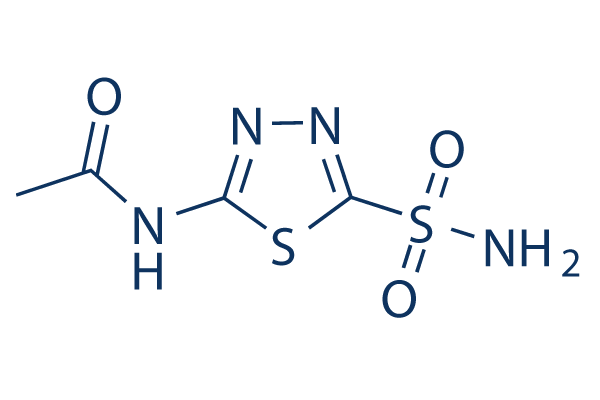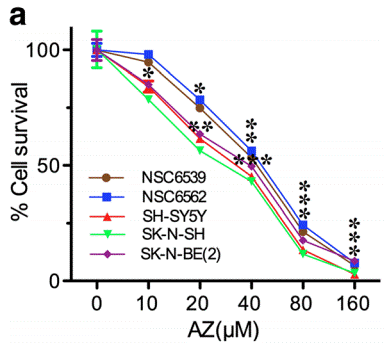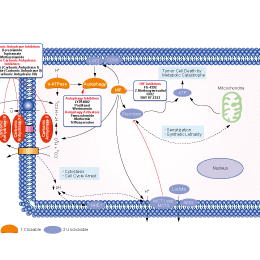
- Bioactive Compounds
- By Signaling Pathways
- PI3K/Akt/mTOR
- Epigenetics
- Methylation
- Immunology & Inflammation
- Protein Tyrosine Kinase
- Angiogenesis
- Apoptosis
- Autophagy
- ER stress & UPR
- JAK/STAT
- MAPK
- Cytoskeletal Signaling
- Cell Cycle
- TGF-beta/Smad
- DNA Damage/DNA Repair
- Compound Libraries
- Popular Compound Libraries
- Customize Library
- Clinical and FDA-approved Related
- Bioactive Compound Libraries
- Inhibitor Related
- Natural Product Related
- Metabolism Related
- Cell Death Related
- By Signaling Pathway
- By Disease
- Anti-infection and Antiviral Related
- Neuronal and Immunology Related
- Fragment and Covalent Related
- FDA-approved Drug Library
- FDA-approved & Passed Phase I Drug Library
- Preclinical/Clinical Compound Library
- Bioactive Compound Library-I
- Bioactive Compound Library-Ⅱ
- Kinase Inhibitor Library
- Express-Pick Library
- Natural Product Library
- Human Endogenous Metabolite Compound Library
- Alkaloid Compound LibraryNew
- Angiogenesis Related compound Library
- Anti-Aging Compound Library
- Anti-alzheimer Disease Compound Library
- Antibiotics compound Library
- Anti-cancer Compound Library
- Anti-cancer Compound Library-Ⅱ
- Anti-cancer Metabolism Compound Library
- Anti-Cardiovascular Disease Compound Library
- Anti-diabetic Compound Library
- Anti-infection Compound Library
- Antioxidant Compound Library
- Anti-parasitic Compound Library
- Antiviral Compound Library
- Apoptosis Compound Library
- Autophagy Compound Library
- Calcium Channel Blocker LibraryNew
- Cambridge Cancer Compound Library
- Carbohydrate Metabolism Compound LibraryNew
- Cell Cycle compound library
- CNS-Penetrant Compound Library
- Covalent Inhibitor Library
- Cytokine Inhibitor LibraryNew
- Cytoskeletal Signaling Pathway Compound Library
- DNA Damage/DNA Repair compound Library
- Drug-like Compound Library
- Endoplasmic Reticulum Stress Compound Library
- Epigenetics Compound Library
- Exosome Secretion Related Compound LibraryNew
- FDA-approved Anticancer Drug LibraryNew
- Ferroptosis Compound Library
- Flavonoid Compound Library
- Fragment Library
- Glutamine Metabolism Compound Library
- Glycolysis Compound Library
- GPCR Compound Library
- Gut Microbial Metabolite Library
- HIF-1 Signaling Pathway Compound Library
- Highly Selective Inhibitor Library
- Histone modification compound library
- HTS Library for Drug Discovery
- Human Hormone Related Compound LibraryNew
- Human Transcription Factor Compound LibraryNew
- Immunology/Inflammation Compound Library
- Inhibitor Library
- Ion Channel Ligand Library
- JAK/STAT compound library
- Lipid Metabolism Compound LibraryNew
- Macrocyclic Compound Library
- MAPK Inhibitor Library
- Medicine Food Homology Compound Library
- Metabolism Compound Library
- Methylation Compound Library
- Mouse Metabolite Compound LibraryNew
- Natural Organic Compound Library
- Neuronal Signaling Compound Library
- NF-κB Signaling Compound Library
- Nucleoside Analogue Library
- Obesity Compound Library
- Oxidative Stress Compound LibraryNew
- Plant Extract Library
- Phenotypic Screening Library
- PI3K/Akt Inhibitor Library
- Protease Inhibitor Library
- Protein-protein Interaction Inhibitor Library
- Pyroptosis Compound Library
- Small Molecule Immuno-Oncology Compound Library
- Mitochondria-Targeted Compound LibraryNew
- Stem Cell Differentiation Compound LibraryNew
- Stem Cell Signaling Compound Library
- Natural Phenol Compound LibraryNew
- Natural Terpenoid Compound LibraryNew
- TGF-beta/Smad compound library
- Traditional Chinese Medicine Library
- Tyrosine Kinase Inhibitor Library
- Ubiquitination Compound Library
-
Cherry Picking
You can personalize your library with chemicals from within Selleck's inventory. Build the right library for your research endeavors by choosing from compounds in all of our available libraries.
Please contact us at info@selleckchem.com to customize your library.
You could select:
- Antibodies
- Bioreagents
- qPCR
- 2x SYBR Green qPCR Master Mix
- 2x SYBR Green qPCR Master Mix(Low ROX)
- 2x SYBR Green qPCR Master Mix(High ROX)
- Protein Assay
- Protein A/G Magnetic Beads for IP
- Anti-Flag magnetic beads
- Anti-Flag Affinity Gel
- Anti-Myc magnetic beads
- Anti-HA magnetic beads
- Poly DYKDDDDK Tag Peptide lyophilized powder
- Protease Inhibitor Cocktail
- Protease Inhibitor Cocktail (EDTA-Free, 100X in DMSO)
- Phosphatase Inhibitor Cocktail (2 Tubes, 100X)
- Cell Biology
- Cell Counting Kit-8 (CCK-8)
- Animal Experiment
- Mouse Direct PCR Kit (For Genotyping)
- New Products
- Contact Us
research use only
Acetazolamide Carbonic Anhydrase inhibitor
Acetazolamide (Diamox), a potent carbonic anhydrase (CA) inhibitor, is commonly used in clinical practice as an immediate and readily available option for acute reduction of intraocular pressure(IOP).

Chemical Structure
Molecular Weight: 222.25
Purity & Quality Control
Batch:
Purity:
99.98%
99.98
Related Products
| Related Targets | Carbonic Anhydrase I Carbonic Anhydrase II Carbonic Anhydrase IV Carbonic Anhydrase IX Carbonic Anhydrase XII | Click to Expand |
|---|---|---|
| Related Products | U-104 Indisulam Benzenesulfonamide | Click to Expand |
| Related Compound Libraries | Metabolism Compound Library Anti-cancer Metabolism Compound Library Glutamine Metabolism Compound Library Carbohydrate Metabolism Compound Library Lipid Metabolism Compound Library | Click to Expand |
Signaling Pathway
Mechanism of Action
| Targets |
|
|---|
In vitro |
||||
| In vitro | acetazolamide reduces invasiveness of cancer cells in vitro[3]. | |||
|---|---|---|---|---|
| Cell Research | Cell lines | renal carcinoma cell lines(Caki-1, Caki-2, ACHN, and A-498) | ||
| Concentrations | 10 μM | |||
| Incubation Time | 48 h | |||
| Method | The invasion assay is performed in a Biocoat Matrigel invasion chamber. Cells (n = 1.8 × 105) are added to the chamber and cultured for 48 h in the presence or absence of acetazolamide, which was administered twice during the 48-h period: the first dose at the beginning of the assay and the second after 24 h. After growing for 48 h, noninvasive cells are removed from the upper surface of the membrane with a cotton swab. The invasive cells on the lower surface of the membrane are fixed with 4% (vol/vol) neutral-buffered formaldehyde, stained with toluidine blue, and counted in 20 separate areas with a Leitz Diaplan microscope. |
|||
| Experimental Result Images | Methods | Biomarkers | Images | PMID |
| Growth inhibition assay | Cell viability |

|
28235409 | |
In Vivo |
||
| In vivo | Acetazolamide reduces inflammation-induced heat hyperalgesia, probably acting both peripherally and centrally[1]. This compound shows significant inhibitory effect on angiogenesis in CAM and endothelial cell proliferation[2]. It is clinically used to reduce intraocular pressure in glaucoma, to correct metabolic alkalosis, and to manage cerebral edema. Its treatment may also be beneficial as an adjunct to cancer chemotherapy, because it can produce additive tumor growth delays with anticancer drugs in vivo[3]. | |
|---|---|---|
| Animal Research | Animal Models | Male Sprague-Dawley rats |
| Dosages | 10, 100, 200 mg/kg | |
| Administration | i.p. | |
| NCT Number | Recruitment | Conditions | Sponsor/Collaborators | Start Date | Phases |
|---|---|---|---|---|---|
| NCT06285760 | Not yet recruiting | Heart Failure|Persistent Congestion |
Puerta de Hierro University Hospital|Hospital Clinic of Barcelona|Hospital Central de la Defensa Gómez Ulla|Hospital Vall d''Hebron|Hospital Universitario Ramon y Cajal|University Hospital of Girona Dr.Josep Trueta|Fundación de Investigación Biomédica - Hospital Universitario de La Princesa |
March 2024 | -- |
| NCT06039475 | Recruiting | Acute Mountain Sickness|High Altitude Pulmonary Edema|High Altitude Cerebral Edema |
B.P. Koirala Institute of Health Sciences |
July 1 2023 | -- |
| NCT06114537 | Recruiting | Retinoschisis |
Academisch Medisch Centrum - Universiteit van Amsterdam (AMC-UvA) |
January 20 2023 | Phase 2 |
| NCT04679389 | Terminated | Pmm2-CDG|CDG1A |
Mayo Clinic|Seattle Children''s Hospital|Children''s Hospital of Philadelphia |
March 17 2021 | Phase 2|Phase 3 |
References |
|
Chemical Information
| Molecular Weight | 222.25 | Formula | C4H6N4O3S2 |
| CAS No. | 59-66-5 | SDF | Download SDF |
| Synonyms | Diamox | ||
| Smiles | CC(=O)NC1=NN=C(S1)S(=O)(=O)N | ||
Storage and Stability
| Storage (From the date of receipt) | |||
|
In vitro |
DMSO : 44 mg/mL ( (197.97 mM) Moisture-absorbing DMSO reduces solubility. Please use fresh DMSO.) Water : Insoluble Ethanol : Insoluble |
Molecular Weight Calculator |
|
In vivo Add solvents to the product individually and in order. |
In vivo Formulation Calculator |
|||||
Preparing Stock Solutions
Molarity Calculator
In vivo Formulation Calculator (Clear solution)
Step 1: Enter information below (Recommended: An additional animal making an allowance for loss during the experiment)
mg/kg
g
μL
Step 2: Enter the in vivo formulation (This is only the calculator, not formulation. Please contact us first if there is no in vivo formulation at the solubility Section.)
% DMSO
%
% Tween 80
% ddH2O
%DMSO
%
Calculation results:
Working concentration: mg/ml;
Method for preparing DMSO master liquid: mg drug pre-dissolved in μL DMSO ( Master liquid concentration mg/mL, Please contact us first if the concentration exceeds the DMSO solubility of the batch of drug. )
Method for preparing in vivo formulation: Take μL DMSO master liquid, next addμL PEG300, mix and clarify, next addμL Tween 80, mix and clarify, next add μL ddH2O, mix and clarify.
Method for preparing in vivo formulation: Take μL DMSO master liquid, next add μL Corn oil, mix and clarify.
Note: 1. Please make sure the liquid is clear before adding the next solvent.
2. Be sure to add the solvent(s) in order. You must ensure that the solution obtained, in the previous addition, is a clear solution before proceeding to add the next solvent. Physical methods such
as vortex, ultrasound or hot water bath can be used to aid dissolving.
Tech Support
Answers to questions you may have can be found in the inhibitor handling instructions. Topics include how to prepare stock solutions, how to store inhibitors, and issues that need special attention for cell-based assays and animal experiments.
Tel: +1-832-582-8158 Ext:3
If you have any other enquiries, please leave a message.
* Indicates a Required Field






































